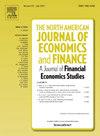我是谁?探索新兴人工智能和物联网代币市场的分位数频率连通性
IF 3.9
3区 经济学
Q1 BUSINESS, FINANCE
North American Journal of Economics and Finance
Pub Date : 2025-07-08
DOI:10.1016/j.najef.2025.102497
引用次数: 0
摘要
本文使用分位数向量自回归(QVAR)和分位数频率连通性方法研究了人工智能(AI)和物联网(IoT)令牌之间的回报溢出和连通性。使用2021年2月至2024年3月10个领先的人工智能和物联网代币的日常数据,我们发现连通性在分位数上既随时间变化又不对称。在短期内,在极端市场条件下,总连通性指数(TCI)峰值为69.58% (τ = 0.05),而在牛市(τ = 0.95)和正常条件下(τ = 0.50), TCI峰值分别为64.16%和61.43%。中期和长期连通性较弱,但不对称仍然存在,因为极端分位数和正常分位数的TCI分别达到10.98%和5.32%(中期),10.52%和2.64%(长期)。这些发现证实,在市场不确定性升高期间,特别是在分布的左尾,回报传播加剧。此外,人工智能和物联网代币既可以提供多样化,又可以相互对冲。我们的分析为投资者、投资组合经理和政策制定者理解系统性风险和优化数字资产投资组合提供了见解。本文章由计算机程序翻译,如有差异,请以英文原文为准。
Who A(m) I? exploring quantile frequency connectedness in emerging AI and IoT token markets
This paper investigates the return spillover and connectedness between Artificial Intelligence (AI) and Internet of Things (IoT) tokens using the Quantile Vector Autoregression (QVAR) and quantile frequency connectedness approach. Using daily data from February 2021 to March 2024 for ten leading AI and IoT tokens, we find that connectedness is both time-varying and asymmetric across quantiles. In the short term, the Total Connectedness Index (TCI) peaks at 69.58 % under extreme market conditions (τ = 0.05), compared to 64.16 % in bull markets (τ = 0.95) and 61.43 % under normal conditions (τ = 0.50). Connectedness is weaker in the medium and long terms, but asymmetry persists as the TCI reaches 10.98 % vs. 5.32 % (medium term) and 10.52 % vs. 2.64 % (long term) for extreme vs. normal quantiles. These findings confirm that return transmission intensifies during periods of elevated market uncertainty, particularly in the left tail of the distribution. Moreover, AI and IOT tokens offer both diversification and hedging benefits against each other. Our analysis provides insights for investors, portfolio managers, and policymakers in understanding systemic risk and optimizing digital asset portfolios.
求助全文
通过发布文献求助,成功后即可免费获取论文全文。
去求助
来源期刊
CiteScore
7.30
自引率
8.30%
发文量
168
期刊介绍:
The focus of the North-American Journal of Economics and Finance is on the economics of integration of goods, services, financial markets, at both regional and global levels with the role of economic policy in that process playing an important role. Both theoretical and empirical papers are welcome. Empirical and policy-related papers that rely on data and the experiences of countries outside North America are also welcome. Papers should offer concrete lessons about the ongoing process of globalization, or policy implications about how governments, domestic or international institutions, can improve the coordination of their activities. Empirical analysis should be capable of replication. Authors of accepted papers will be encouraged to supply data and computer programs.

 求助内容:
求助内容: 应助结果提醒方式:
应助结果提醒方式:


